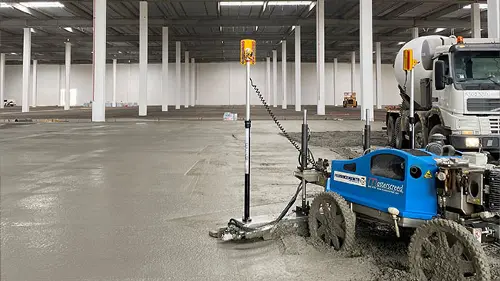

Projects
/
7/31/2025
Towards a more sustainable precast industry: Modular Prefab Construction at MIND now includes Mapei fibers
MAPEFIBRE ST 40 PLUS, combined with Mapei’s contribution to a University of Brescia research project, has given rise to the second phase of the Federated Innovation @MIND pilot project, focusing on modular units made of precast fibre-reinforced concrete and timber
The second phase of the Modular Prefab Construction project incorporates Mapefibre ST 40 Plus macro-synthetic fibres into precast modular slabs made of concrete-and-timber to reinforce the concrete, while also enhancing its mechanical performance, sustainability and modularity. Using Mapefibre ST 40 Plus reduces the need for conventional reinforcement, promotes a circular economy and simplifies the precast production process. Presented at the FIB 2025 symposium, the project provides an innovative solution for the future of construction.
On 5 December 2024 Federated Innovation @MIND (a public-private ecosystem within the Milano Innovation District that brings together companies, researchers, and institutions to co-create innovative solutions) presented in Milan Modular Prefab Construction: a modular construction system developed by Lendlease and Wood Beton with the support of Mapei. It was a pilot project involving the use of concrete mixed with Mapei admixtures to create a slab incorporating a timber section produced by Woodbeton. This modular unit is earmarked for use in the floor-slabs of the Horizon skyscraper, currently under construction in Milan, in the area where Expo 2025 was held and which is now the location of MIND – Milan Innovation District – a state-of-the-art urban district due for completion by 2030, which will host scientific, healthcare and education centres, alongside a global innovation hub and the mixed-use West Gate quarter.

Mapei, Wood Beton and Saint-Gobain collaborated on the first phase of the pilot project by @Federated Innovation that led to the creation of the Modular Prefab System. Representatives of the companies presented it on 5 December in Milan.
From the outset, construction professionals have hailed Modular Prefab Construction as a major innovation, capable of delivering high standards of sustainability, reducing construction times and improving occupational safety. And Mind and Mapei were determined to keep moving forward. Since then, the research project has continued and involved the University of Brescia’s Department of Civil Environmental Engineering, Land Management, Architecture and Mathematics (DICATAM) and some of its nationally and internationally renowned researchers in innovative building materials, such as Prof. Giovanni Plizzari and Luca Facconi.

The second phase of the project involved the University of Brescia’s Department of Civil Environmental Engineering, Land Management, Architecture and Mathematics (DICATAM). Prof. Giovanni Plizzari presented it at FIB 2025 Symposium in Antibes last June.
The second phase of the research project saw the introduction of an important innovation, in the form of Mapefibre ST 40 Plus synthetic macro-fibers supplied by Mapei and deployed both in the concrete mix used to make the slab in conjunction with the timber section, and in the concrete connectors that hold the two elements together. In fact, the research project included a campaign of experiments and various tests on a prototype modular slab made of pre-cast fibre-reinforced concrete panels, connected to a timber joist system by means of dry-fixing concrete connections.
Why add fibers to concrete?
Mapefibre ST 40 Plus fibers are used because they enhance certain properties of concrete, such as the post-cracking behaviour and the resistance to fatigue, providing the material with more ductility. All these aspects make it possible to reduce or eliminate the traditional steel reinforcements normally used in this type of building works.
Adding fibers to concrete mixes boosts sustainability for many reasons: firstly, waste can be recovered and re-used in the production of these mixtures, making them “zero waste” products. Unlike rebar, furthermore, fibers are added directly to the concrete mixture, thus considerably reducing the time and risk associated with the production, transportation and use of conventional reinforcement materials, while also cutting the time and cost of completing the work.
What’s more, in Modular Prefab Construction, the fibers help create a modular unit that can be reused at the end of the life-cycle of the structure it is incorporated into, thus promoting a circular economy in which waste materials are used for new construction projects, without any need to break up the concrete units to separate them from the rebar.

Mapefibre ST40 Plus fibers were added to both the concrete used for the connectors and the concrete mix used for the slab.
What the tests show
With regard to the fibre-reinforced concrete connectors, the tests, carried out using a BRT machine and in line with the procedures set down in European Technical Standard Eurocode 5 and Appendix C of Technical Specification CEN/TS 19103, examined the maximum weight borne by the connectors, their local rigidity and their bending strength. The results clearly show that the maximum load, displacement and stiffness values are not affected by the presence of the fibres. In fact, they showed that the addition of fibers significantly increases the ductility of the connectors, which results in better distribution of shear forces among connectors, thus improving the behaviour of the precast modular slab.
Finite element modelling was also used to study the behaviour of the structural element made with fibre-reinforced concrete, not only to simulate the static state but also to replicate the loads triggered by seismic action. The testers concluded that, thanks to the fibre-reinforced concrete, the floor-slab ensures optimum load distribution across the unit. This design and software simulation phase will be followed by a final phase of large-scale testing, on the entire fibre-reinforced panel in its actual dimensions.
Promising results presented at FIB 2025 symposium
The results of the research project are very encouraging and show that the fibre-reinforced concrete-and-timber unit on which the study focused is an innovative technical solution for the construction industry, with the ability to promote sustainability, safety and efficiency in the precast industry. Modularity, sustainability and precast production make this modular unit an excellent alternative to traditional construction methods, which is also durable and adaptable to various types of buildings, while optimising the life cycle of the materials used.
The results of the research project formed the subject of a paper and a presentation at the 2025 Symposium of the International Federation for Structural Concrete (FIB), held in Antibes, France, from 16 to 18 June. Mapei, which sponsored the event, also took part in the session on the use of synthetic macro-fibers. During this session, a panel of professionals from the Concrete Flooring Solutions (CFS) line, including Matteo Draconte, Mapei Corporate Product Line Specialist - Fibers and CFS, presented three papers on innovations in the construction industry. The first two focused on the use of synthetic fibers in recycled or regenerated plastics and on the hybrid and synergistic use of synthetic fibers and steel, while the third focused specifically on Modular Prefab, an innovative system involving synthetic fibers to produce precast concrete units that are ideal for use in smart-building projects.
Research and innovation have always formed the cornerstone of Mapei’s business and growth. They also underpin the launch of valuable collaborations with universities, trade associations and contracting authorities responsible for small- and large-scale works alike. Modular Prefab is simply the latest exemplar of successful values and strategies, as well as being an innovative example of a smart construction process for the sustainable buildings of tomorrow.









